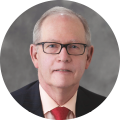Dear colleagues and friends of the Academy,

April 2019 marks the conclusion of my 10th year as our Academy’s CEO. It’s a position I’m very honored to hold and carries with it a humbling set of responsibilities to our profession and to our society. Although I cared for a patient last in 2009, I spent the prior 26 years as an ophthalmologist in active practice. When people ask me what I do, I don’t say, “I’m the Academy’s CEO.” I respond, “I’m an ophthalmologist.” That is my core identity and represents the central perspective from which I view the issues and forces that impact our professional world.
Much has changed in medicine during the past decade. Some of it has been very disruptive to clinical practice and to the patient-physician relationship. The Affordable Care Act (Obamacare) was signed into law in March 2010, representing the most impactful overhaul of the U.S. healthcare system since Medicare 45 years earlier. Nine years later, we are still slogging our way through thousands of pages of enabling regulations and changes to those regulations. The fundamental “volume to value” payment shift impacts us all.
We are also “living the dream” as medicine adapts to its digitalization. In 2009, fewer than 30 percent of ophthalmologists used an electronic health record (EHR) system; now it is over 70 percent. Most dislike it. Many of us long for the days of paper charts when physicians didn’t face the screen instead of the patient or didn’t employ scribes to handle the data entry. But they are here to stay. The 20 percent of the U.S. economy that is health care was the last major segment to become digitized.
Many of the changes are positive ones. These same EHRs can make it possible to access patient records from our laptops, home computers and secondary offices; view lab work and imaging studies; and order medications. They can lessen the chance for medication errors and provide useful practice management data. Science is providing us with new tools, which, when fully mature, have the promise of revolutionizing care. Consider that in the last decade the cost to sequence the human genome has gone from about $10 million to about $1,000! And that biomarkers are ushering a true era of precision medicine in the management of tumors, inherited diseases and other disorders.
The American Academy of Ophthalmology and its mission have remained central to the future of our wonderful profession. It is the Academy’s responsibility to develop tools and resources for ophthalmologists in training and ophthalmologists in practice to sift through information that now doubles in less than two years and to stay at the cutting edge of knowledge and skills. These too have largely (but not completely) moved from paper to digital content.
And the Academy has also focused intently on representing the profession to the public and to policymakers. Its websites now attract about 8 million visitors each year. It projects the value of ophthalmology and of eye care through print, video, media partners, podcasts and social media. And a key part of that is compiling the evidence to support the valuation of the work we do as ophthalmologists. More and more of that derives from mining the data trove within the IRIS® Registry (Intelligent Research in Sight).
In the pages that follow, you will learn more about many Academy programs about which you may be totally unaware. If there are two things that I underestimated when I accepted this role 10 years ago, they were (1) the fantastic breadth of Academy responsibilities and activities — many of which are under the radar screen of the typical member, and (2) the degree to which the Academy depends upon the spirit and work of member volunteers to fulfill its responsibilities. When the Academy takes on a new initiative, advocates for legislation or regulation or addresses a policy stand, these actions are based on advice, expertise and/or leadership by hundreds of our colleagues.
They not only contribute to the Academy’s strength and resiliency, but sustain a professional culture of respect, collegiality, community and innovation. This helps us stay true to our mission.
We are the Academy, and I am privileged to serve our profession among you.
Sincerely,
David W. Parke II, MD
Chief Executive Officer